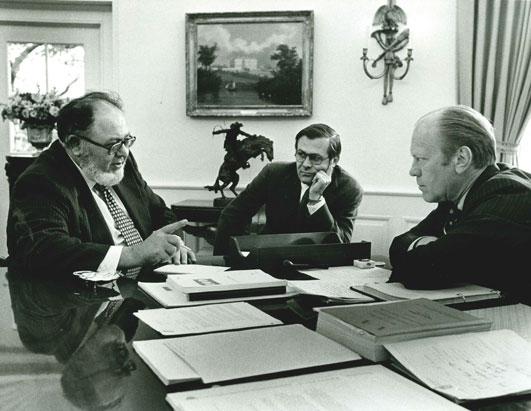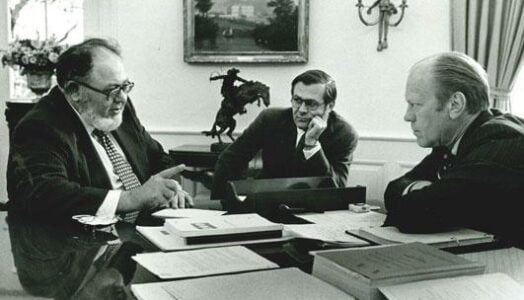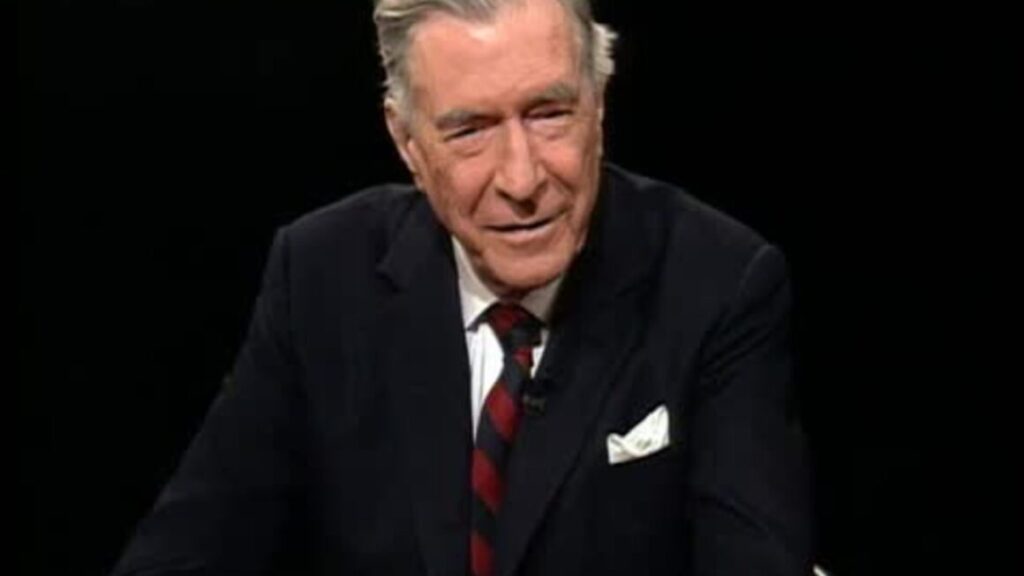Herman Kahn (the real Dr. Strangelove) was a CFR member, military/nuclear strategist, founder of the Hudson Institute, worked for the Rand Corporation, and one of the preeminent futurists of the latter part of the twentieth century. He was born in Bayonne, NJ on 15 February 1922 to Yetta and Abraham Kahn. He was brought up in the Bronx with a Jewish upbringing, but would later become atheistic in his beliefs. Throughout the 1950s, Khan would write various reports at the Hudson Institute on the concept and practicality of nuclear deterrence, which would subsequently become official military policy. He would also compile reports for official hearings, such as the Subcommittee on Radiation. It is in the primordial hysteria of the earliest years of the Cold War where Kahn would be given the intellectual, and some may say ethical and moral, space to “think the unthinkable”. Khan would apply game theory – the study of mathematical models of strategic interactions among rational agents – to wargame potential scenarios and outcomes concerning thermonuclear war.
In 1960, Kahn would publish, The Nature and Feasibility of War and Deterrence, which studied the risks and subsequent impact of a thermonuclear war. The Rand Corporation sums up the kinds of deterrents discussed in Kahn’s work as: the deterrence of a direct attack, the use of strategic threats to deter an enemy from engaging in very provocative acts other than a direct attack on the United States, and, lastly, the acts that are deterred because the potential aggressor is afraid that the defender or others will take limited actions, military or non-military, to make the aggression unprofitable.
The following year, Princeton University Press would first publish Herman Kahn’s seminal work, On Thermonuclear War. This book would have an enormous impact on the near and distant future of global politics and would drive American Establishment politicians to create foreign policy specifically designed to counter the potential worst case thermonuclear scenario. On the release of Kahn’s terrifying work, the Israeli-American sociologist and “communitarian”, Amitai Etzioni, would be quoted as saying, “Kahn does for nuclear arms what free-love advocates did for sex: he speaks candidly of acts about which others whisper behind closed doors”.
Khan’s complex theories have often been erroneously paraphrased, with most of his work being impossible to sum up in just a sentence or two, and this is emblematic of his ideas concerning thermonuclear war. Kahn’s research team were studying a multitude of different scenarios, a constantly evolving, dynamic, multipolar world, and many unknowns.
On Thermonuclear War had an instant and lasting impact, not only on geopolitics, but also on culture, expressed within a few years by a very famous movie. 1964 saw the release of the Stanley Kubrick classic, Dr Strangelove, and from the moment of its release, and ever since, Khan has been referred to as the real Dr. Strangelove. When quizzed about the comparison, Khan would tell Newsweek, “Kubrick is a friend of mine. He told me Dr. Strangelove wasn’t supposed to be me.” But others would point out the many affinities between Stanley Kubrick’s classic character and the real life Herman Kahn.
In an essay written for the Council on Foreign Relations in July 1966, entitled, Our Alternatives in Europe, Kahn states:
“Existing U.S. policy has generally been directed to the political and economic as well as the military integration or unification of Western Europe as a means to European security. Some have seen unification as a step toward the political unity of the West as a whole, or even of the world. Thus, the achievement of some more qualified form of integration or federation of Europe, and of Europe with America, has also been held to be an intrinsically desirable goal, especially as national rivalries in Europe have been seen as a fundamentally disruptive force in modern history; hence their suppression, or accommodation in a larger political framework, is indispensable to the future stability of the world.”
This statement suggests that the preferred solution for future European/American relations would be the creation of a European union. Even more preferable to Kahn was the idea of creating a unified American and European superstate.
In 1967, Herman Kahn would write one of the most important futurist works of the 20th century, The Year 2000: A Framework for Speculation on the Next Thirty-Three Years. In this book, co-authored by Anthony J Wiener, Khan and company predicted where we would be technologically at the end of the millennium. But there was another document released soon after Kahn’s The Year 2000, which had been written simultaneously. That document entitled, Ancillary Pilot Study for the Educational Policy Research Program: Final Report, was to map out how to achieve the future society Kahn’s work in The Year 2000 had envisaged.
Under a section titled “Special Educational Needs of Decision-Makers”, the paper states: “The desirability of explicitly educated decision-makers so that they are better able, in effect, to plan the destiny of the nation, or to carry out the plans formulated through a more democratic process, should be very seriously considered. One facet of this procedure would be the creation of a shared set of concepts, shared language, shared analogies, shared references…” He goes on to state in the same section that: “Universal re-teaching in the spirit of the humanistic tradition of Europe – at least for its comprehensive leadership group – might be useful in many ways.”
When you study the previously mentioned rhetoric and decipher what it means, in this document Herman Kahn suggests subverting democracy by training only a certain group in society as potential leaders, with those pre-selected few who are groomed for power being able to define what our shared values as a society should be. Maybe Herman Kahn would agree with the World Economic Forum’s Young Global Leader scheme, which is the exact manifestation of his original suggestion.
In 1968, Herman Kahn would be asked by a reporter what they do at the Hudson Institute. He would say, “We take God’s view. The President’s view. Big. Aerial. Global. Galactic. Ethereal. Spatial. Overall. Megalomania is the standard occupational hazard.” This was reportedly followed by Herman Kahn rising out of his chair, pointing his finger towards the sky and suddenly shouting out: ‘Megalomania, zoom!’”
In 1970, Kahn would travel to Europe with Galbraith to support Klaus Schwab’s recruitment drive for the first European Management Symposium. In 1971, Kahn would be sitting center stage to watch John Kenneth Galbraith’s keynote speech at the historic first session of the policy making organization which would eventually become the World Economic Forum.
In 1972, the Club of Rome published “The Limits to Growth”, which cautioned that the needs of the global population would exceed available resources by the year 2000. Kahn spent much of his final decade arguing against this idea. In 1976, Khan would publish a more optimistic view of the future, The Next 200 Years, which claimed that the potentials of capitalism, science, technology, human reason, and self-discipline were boundless. The Next 200 Years would also dismiss pernicious Malthusian ideology by predicting that the planet’s resources set no limits to economic growth, but rather, human beings would “create such societies everywhere in the solar system and perhaps to the stars as well.”
Kahn, Henry Kissinger and Ken Galbraith had become three of the most influential people in America with regards to thermonuclear deterrence, foreign policy creation, and public policy making, respectively. Most of the focus throughout these men’s career had been on Europe and the Cold War. However, their varying roles in other important events of the period all have the potential to easily distract researchers from other more subversive and well hidden events.
These three powerful Americans were all linked with each other in various ways, but one interesting and notable thread in particular ties these men together during the period between 1966, with the creation of the Kissinger-led 22 man panel of advisors to help “shape European policy”, through to 1971, and the founding of the World Economic Forum. All three men were members of the Council on Foreign Relations, the American branch of the Anglo-American imperialist “Round Table” movement. Kissinger already had deep ties to the CFR, having been recruited by them straight after graduation. Galbraith had reportedly resigned his membership of the CFR in a “highly public way” in 1972, stating that the CFR was boring and telling a journalist, “Most of the proceedings involve a level of banality so deep that the only question they raise is whether one should sit through them.” Although there is no public date of when Galbraith became a member of the CFR, he had written for their publications from as early as July 1958 with “Rival Economic Theories in India,” being printed in Foreign Affairs, the official CFR journal/magazine. Khan could also be found publishing some of his essays through the CFR, writing the piece “Our Alternatives in Europe” in July 1966, and “If Negotiations Fail” in July 1968, both whilst working as an official advisor to the State Department.
Before the 1960s, these three extremely influential American intellectuals had each been deeply involved in trying to understand the problems of a postwar Europe, and mapping out the future of the war-stricken continent. Galbraith had traveled extensively throughout Europe, including studying policies in Germany during the Third Reich, and, after the collapse of Hitler’s Germany, Galbraith would go on to study the Soviet systems in much the same way. Galbraith’s influence over the future president, John F. Kennedy, from a very early age cannot be understated, and Galbraith was powerful enough to see JFK begin withdrawing troops from Vietnam on his recommendation. When Kennedy was assassinated in Dallas, Galbraith would be the man to draft the incoming president’s initial address to the nation, but Galbraith was soon to be pushed off to the sidelines. During the turmoil of the 1960s, Galbraith would be close with Henry Kissinger, both men being Harvard Professors, members of the CFR, and both men having the same goal of making Europe stable so that the Continent was well defended against any potential Soviet aggression.
To Galbraith and Kissinger, and also to the wider American political Establishment, Europe was the main threat to not only global stability, but also to the prevailing American hegemony in general. The relative stability in Europe during the postwar period was perceived as being due to the thermonuclear stand-off, and, from very early-on, Kissinger identified this dynamic and began to manipulate the situation for the benefit of American supremacy. Henry Kissinger was not alone in trying to understand the complex dynamics at play in relation to thermonuclear deterrence and how it affected policy making. Herman Kahn was the leading figure on thermonuclear strategic planning during the same period and Kissinger’s work concerning the same subject matter from the mid-50s onwards would see him cross paths with Kahn on many occasions.
Kahn offered Kissinger something which all politicians and policy makers crave, the ability to predict future events with relative accuracy. Kahn was a veritable prophet concerning the technological advancements of the not-so-distant future, and his work, although often stoic and bereft of human emotion, has stood up very well to the test of time. Kahn and Kissinger’s goals would overlap during the mid and late 1960s, and as the threat assessments Kahn made during this period became more optimistic, Kissinger would see Kahn’s work as being fundamental in offering a new future to the people of the world.
However, Henry Kissinger’s vision of the future was not of a free and fair society advancing into a “brave new world” together, but rather, Kissinger intended to create an image of the world which had been skewed by his own CFR-driven Establishment perspective. Although he would attempt to rebrand himself as a true statesman, Kissinger would continue to subvert not only foreign democratic processes, but also to undermine the American system for the eventual benefit of a globalist agenda. When Schwab was first recognized by Kissinger as a potential future globalist leader, the relatively young German would soon be introduced to Galbraith and Kahn. This would coincide with Kahn’s work identifying the need to specifically train individuals with leadership potential separately from those who attend the prevailing standard educational models.
In the year Klaus Schwab left Harvard, he was approached by Peter Schmidheiny, who had just sold Escher Wyss to the Sulzer Group. Escher Wyss’ Ravensberg factory during World War II had been managed by Schwab’s father, Eugen Schwab, and had been involved in making heavy water turbines for the secretive Nazi atomic bomb effort. Schwab speaks in one interview about the moment Schmidheiny called him up, saying, “You come from Harvard now and know modern management methods, help to make the integration a success”. What Klaus wouldn’t mention in that interview is that he would help Sulzer and Escher Wyss to merge, resulting in a new company called Sulzer AG. That company, where Schwab would serve as director, which would go on to break international law by aiding the South African apartheid regime in its illegal thermonuclear bomb program.
Klaus Schwab had only just left the sphere of influence of some of the most significant experts in thermonuclear war, and within the same year as leaving Harvard, he would head up the merger of a company dealing in the propagation thermonuclear bomb technology to despotic regimes.
For many of us who don’t map out terrifying extinction scenarios, we may be left believing that apartheid South Africa gaining the nuke at this point in history would be one of the worst things that could’ve happened. But, Herman Kahn’s thermonuclear disaster scenarios had led the rotund genius to believe that, barring a disaster, sabotage, or an accident, no major nuclear power would dare fire a thermonuclear weapon as an act of aggression for the foreseeable future. In fact, the Establishment thinking had changed significantly, to the point where Herman Kahn and others were advising that, in certain scenarios, making a country such as France a nuclear power could have significant benefits to security both regionally and globally, whilst also helping to reduce US defense spending.
Thermonuclear war was no longer the be all and end all of strategic defense policy, and it was in the dying embers of the 1960s where the same people who had caused all of the fear of a thermonuclear apocalypse, really did stop worrying and learnt to love the bomb.
Whilst at Harvard, Schwab would attend Kissinger’s “International seminar” which was funded by the CIA via a known conduit. Through this process, Klaus Schwab would be introduced to a group of men who were actively trying to influence European public policy by any and all methods, including using the fear of impending nuclear doom. They would recognise his potential straight away, so much so that they would be there for Schwab all through the founding of the World Economic Forum, with Kahn, Kissinger and Galbraith bringing perceived credibility to the project. It was not easy for Schwab alone to explain to European elites what he intended to do, so he would bring Kahn and Galbraith to Europe to persuade other important players to become part of the project. Galbraith would be the first Keynote Speaker at the forum, with Kahn’s presence also drawing significant interest, but the second World Economic Forum would stall without the presence of the bigger names and Klaus Schwab knew he would need something to draw in the crowds for the third installment of his forum’s annual meeting.
Klaus Schwab would soon become everything Herman Kahn had feared during his most pessimistic predictions. When the Club of Rome produced “The Limits to Growth” report, Herman Kahn would refute its findings and rally against its pessimism, whilst, at the same time, Klaus Schwab would make it central to his machinations and have their founder be the keynote speaker at his forum in Davos.
Since the late 1960s, Klaus Schwab has been trying to create the world which Herman Kahn predicted. But Kahn’s vision of the future, even though pretty accurate, is over half a century old. Schwab’s technocratic movement depends on the successful development of innovative technologies which will advance us towards a vision largely manufactured in 1967. Just by studying a more refined list of Kahn’s predictions, you can see every idea which Schwab promotes is almost entirely based on Kahn’s “Year 2000” and that documents vision of what our future may look like, predictions dating back to the late 60’s. But, what Schwab appears to ignore, whilst forcing this futuristic agenda on us all, is that many of Kahn’s predictions were also combined with warnings of the dangers which will be created from future technological advancements.
Herman Kahn would write something extremely significant during the same year in which Schwab would leave Harvard. In the aforementioned Hudson Institute document of 1967 entitled, Ancillary Pilot Study for the Educational Policy Research Program: Final Report, Khan writes:
“It has become increasingly clear that our technological and even our economic achievements are mixed blessings. Through progress issues arise such as the accumulation, augmentation, and proliferation of weapons of mass destruction; the loss of privacy and solitude; the Increase of governmental and/or private power over individuals; the loss of human scale and perspective and the dehumanization of social life or even of the psychobiological self; the growth of dangerously, vulnerable, deceptive, or degradable centralizations of administrative or technological systems; the creation of other new capabilities, so inherently dangerous as to seriously risk disastrous abuse; and the acceleration of changes that are too rapid or cataclysmic to permit successful adjustment. Perhaps most crucial, choices are posed that are too large, complex, important, uncertain, or comprehensive to be safely left to fallible humans.”




